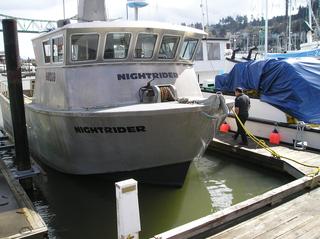False Pass Becomes A Laboratory For Coastal Energy

Wednesday, September 26 2012
The tiny Aleutian village of False Pass is about to become a lab for cutting-edge renewable energy. If the experiment works, False Pass will the first town in the country to be powered by ocean currents.
The impetus for the project came a few years ago, when a handful of community leaders from all across the Bering Sea met up to talk energy. The top priority – to get away from expensive diesel, once and for all.
Bruce Wright, a scientist for the Aleutian Pribilof Islands Association, or APIA, was at the table.
"One particularly big goal was to reduce our fossil fuel usage by 80%," Wright says. "Another objective that came out of that was to get a renewable energy project in every Aleut community.
Wright’s job is to investigate renewable energy sources throughout the Aleutians. Now, he wants to see if ocean turbines can use currents to power the 37-person town of False Pass. It's similar to how wind turbines are used on land.
Alaska has an insanely strong current system, but it’s never been harnessed. A recent Department of Energy report determined that the state’s waters could power every house West of the Mississippi river, and then some.
"That water that is moving in this stream, the Alaska coastal current, is moving toward the Arctic Ocean. And the first place it cuts through the Aleutian islands is False Pass," Wright says. "So I thought, maybe there’s an ocean current project [or] study that we could do there. Maybe there’s a potential for producing ocean energy using ocean current."
Not only is Wright working with a great location – he’s got good timing. The DOE is aggressively pursuing ocean energy projects to meet the country’s clean energy goals. That’s why they’re investing $200,000 in a tribal energy grant to study the currents at False Pass.
At the end of the month, Wright and a team of researchers will use that money to set up a temporary floating lab on a halibut longliner. They’ll be looking for sweet spots where water speeds are at least five miles per hour. They’ll also be trying to figure out what type of water turbine could work best with the environment.
"The one that I’m really interested in is the one that doesn’t kill fish and marine mammals, for obvious reasons," says Wright. "This is a horizontal-axis turbine that runs at low speeds. So it doesn’t turn very fast, and from the video footage I’ve seen, fish tend to avoid it. They can even swim through it without getting killed."
It’s too early to say how much money it would take to move False Pass to all-ocean power. But if they made the transition, the town wouldn’t have to worry about rising oil costs anymore. Once Wright’s team can figure out how to power False Pass, he says other Alaskan communities could start harvesting ocean current, too.
"And if we can capture it in False Pass, we can capture it all the way up – all the way up! You know? This could be the first of 500 power plants all along the coast," he says."
And if the project works out and the DOE's projections are right, that would provide more energy than Alaska's communities would even know what to do with.



